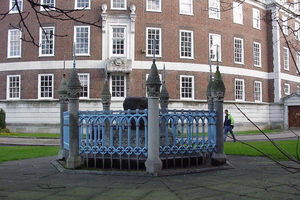The Coronation Stone in London, England

The name “Kingston” gives some indication about the historical importance of this Thames-side town, located just southwest of the hustle and bustle of London. This small enclave has a unique royal connection.
Towards the end of the 10th-century, the town sat near the border of the ancient kingdoms of Wessex and Mercia. In 925 CE, when Saxon king Athelstan united the kingdom and his coronation was held in “Cyninges tun.” During the ceremony, he sat on this very large sarsen block later dubbed, the “Coronation Stone.”
The stone was used in six other coronations for kings that included, Eadred, Ethelred the Unready, Edward the Elder, Edmund I, Eadwig, and Edward the Martyr. All were allegedly consecrated upon the massive rock.
The stone was originally located at the ancient church of St Mary, which collapsed in 1730. Since then, it has moved around Kingston a few times before it was placed at its current site between the Guildhall and the police station during the late 19th-century.
Despite the bright blue fence, most people pass the stone without even realizing its historical significance or its importance to the English kings of the Middle Ages. The Kingston council did announce plans to move the stone back to the churchyard in the center of the to increase its visiblity, yet it remains in the same location several years later.





